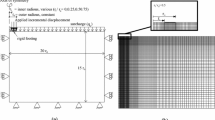Abstract
In this research, a numerical algorithm was proposed for evaluating the bearing capacity of rough strip footing rested on horizontal half-plane using the stress characteristics method. The bearing capacity coefficients, the layout of stress characteristic lines as well as the geometric specifications of the plastic and non-plastic regions beneath the footing for different values of internal friction angles have been calculated. The obtained results were in good agreement with those reported in the literature for \(\varphi \le {25}^{^\circ }\). The results revealed that by increasing the internal friction angle, the bearing capacity coefficients, as well as the depth of the plastic domain beneath the footing increase and the emergence point of the non-plastic curved wedge moves toward the footing edges. It was also shown that the roughness only affects the bearing capacity factor due to the unit weight and the maximum depth affected by the stress characteristic lines beneath the rough footing was almost \(0.62\) times the footing's width which corresponds to \(\varphi ={25}^{^\circ }\).












Similar content being viewed by others
Notes
Bearing capacity of rough footing (\(\mathrm{B}\mathrm{C}\mathrm{R}\mathrm{F}\)).
References
Haghbin M (2016) Bearing capacity of strip footings resting on granular soil overlying soft clay. Int J Civ Eng 14(7):467–477. https://doi.org/10.1007/s40999-016-0067-5
Arabpanahan M, Mirghaderi SR, Hosseini A, Sharif AP, Ghalandarzadeh A (2019) Experimental-numerical investigation of embedment effect on foundation behavior under vertical loading. Int J Civ Eng 17(12):1951–1969. https://doi.org/10.1007/s40999-019-00437-y
Salamatpoor S, Jafarian Y, Hajiannia A (2019) Bearing capacity and uneven settlement of consecutively constructed adjacent footings rested on saturated sand using model tests. Int J Civ Eng 17(6):737–749. https://doi.org/10.1007/s40999-018-0295-y
Chen T, Xiao S (2020) An upper bound solution to undrained bearing capacity of rigid strip footings near slopes. Int J Civ Eng 18(4):475–485. https://doi.org/10.1007/s40999-019-00463-w
Ghasemzadeh H, Akbari F (2020) Investigation of soil active wedge angle with linear matric suction distribution below the footing. Int J Civ Eng 18(2):161–168. https://doi.org/10.1007/s40999-019-00426-1
Sokolovskii VV (1965) Statics of granular media. Pergamon Press, New York. https://doi.org/10.1016/C2013-0-02268-2
Booker JR, Davis EH (1977) Stability analysis by plasticity theory. In: Desai CS, Christian JT (eds) Numerical methods in geotechnical engineering. McGraw Hill, New York, pp 719–748
Hansen JB (1970) A revised and extended formula for bearing capacity. Danish Geotech Inst 28(1):5–11
Martin CM (2004) ABC-analysis of bearing capacity v1.0. Software and documentation. https://www.eng.ox.ac.uk/civil/people/cmm/software/abc. Accessed 14 Dec 2014
Martin CM (2003) New software for rigorous bearing capacity calculations. In: International symposium on foundations: innovations, observations, design, and practice, Dundee, pp 581–592
Martin CM (2005) Exact bearing capacity calculations using the method of characteristics. In: International conference on analytical and computational methods in geomechanics (IACMAG), Torino, Italy, pp 441–450
Kumar J (2003) Nγ for rough strip footing using the method of characteristics. Can Geotech J 40(3):669–674. https://doi.org/10.1139/t03-009
Kumar J (2009) The variation of Nγ with footing roughness using the method of characteristics. Int J Numer Anal Meth Geomech 33(2):275–284. https://doi.org/10.1002/nag.716
Lotfizadeh MR, Kamalian M (2016) Estimating bearing capacity of strip footings over two-layered sandy soils using the characteristic lines method. Int J Civ Eng 14(2):107–116. https://doi.org/10.1007/s40999-016-0015-4
Kamalian M, Goldasteh M, Amoli R, Rahmani I (2013) Estimation of seismic bearing capacity coefficients of strip foundations adjacent to the top of slops by the stress characteristic method. Sharif J Civ Eng 29-2(3):81–90 (in Persian)
Kamalian M (2014) Estimation of seismic bearing capacity of strip foundations on slopes by the stress characteristic method. Research report, International Institute of Earthquake Engineering and Seismology (IIEES), vol 6309, p 93 (in Persian)
Farnia N, Askari F (2003) Calculation of seismic bearing capacity factors of strip footings in the adjacent of slops by the characteristic lines method. Dissertation, International Institute of Earthquake Engineering and Seismology (in Persian)
Keshavarz A, Jahanandish M, Ghahramani A (2011) Seismic bearing capacity analysis of reinforced soils by the method of stress characteristics. Iran J Sci Technol Trans Civ Eng 35(2):185–197. https://doi.org/10.22099/ijstc.2012.666
Jahanandish M, Keshavarz A (2005) Seismic bearing capacity of foundations on reinforced soil slopes. Geotext Geomembr 23(1):1–25. https://doi.org/10.1016/j.geotexmem.2004.09.001
Keshavarz A, Kumar J (2017) Bearing capacity computation for a ring foundation using the stress characteristics method. Comput Geotech 89:33–42. https://doi.org/10.1016/j.compgeo.2017.04.006
Kumar J, Ghosh P (2005) Bearing capacity factor Nγ for ring footings using the method of characteristics. Can Geotech J 42(5):1474–1484. https://doi.org/10.1139/t05-051
Smith CC (2005) Complete limiting stress solutions for the bearing capacity of strip footings on a Mohr–Coulomb soil. Géotechnique 55(8):607–612. https://doi.org/10.1680/geot.2005.55.8.607
Kamalian M, Behnia C, Lotfizadeh M, Rastegar A (2011) Considerations about load inclination effect on seismic bearing capacity factors of strip foundations. J Civ Surv Eng 45(4):495–504 (in Persian)
Kamalian M (2007) Estimation of friction effect on seismic bearing capacity of strip foundations by the characteristic method. Research report, International Institute of Earthquake Engineering and Seismology (IIEES), vol 6118, pp 89–84 (in Persian)
Bolton MD, Lau CK (1993) Vertical bearing capacity factors for circular and strip footings on Mohr–Coulomb soil. Can Geotech J 30(6):1024–1033. https://doi.org/10.1139/t93-099
Terzaghi K (1943) Theoretical soil mechanics. Wiley, New York. https://doi.org/10.1002/9780470172766
Behnia C, Tabatabai AM (1988) Soil mechanics, vol 1. Tehran University Pub. Co, Tehran
Meyerhof GG (1951) The ultimate bearing capacity of foudations. Geotechnique 2(4):301–332. https://doi.org/10.1680/geot.1951.2.4.301
Griffiths DV (1982) Computation of bearing capacity factors using finite elements. Geotechnique 32(3):195–202. https://doi.org/10.1680/geot.1982.32.3.195
Acknowledgements
This research was performed as a part of Ph.D. thesis of the author.
Author information
Authors and Affiliations
Corresponding author
Rights and permissions
About this article
Cite this article
Ahmadi, S., Kamalian, M. & Askari, F. Evaluation of the Static Bearing Capacity Coefficients of Rough Strip Footing Using the Stress Characteristics Method. Int J Civ Eng 19, 155–165 (2021). https://doi.org/10.1007/s40999-020-00539-y
Received:
Revised:
Accepted:
Published:
Issue Date:
DOI: https://doi.org/10.1007/s40999-020-00539-y




